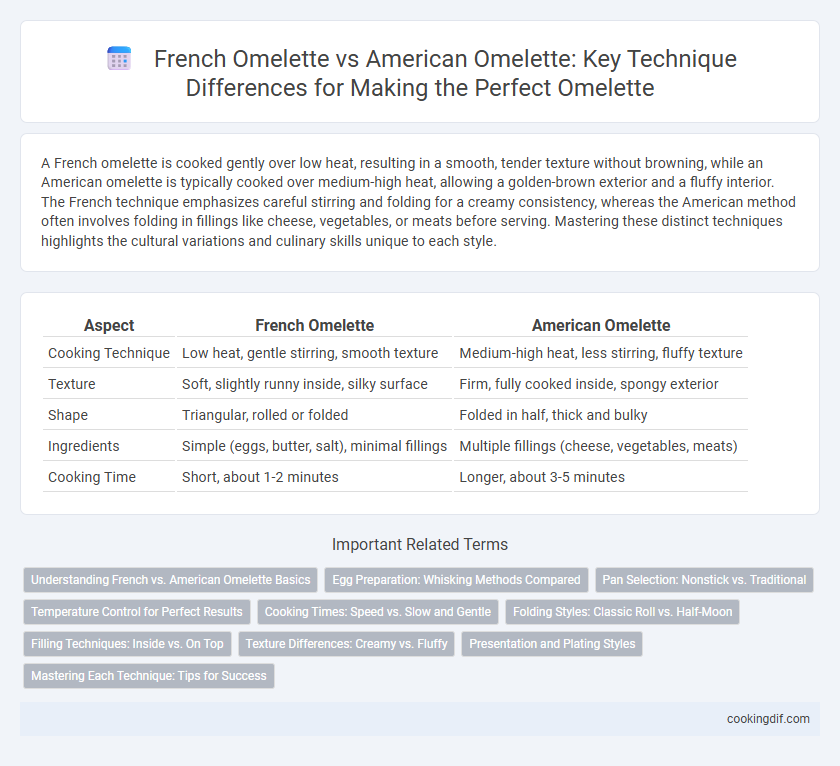A French omelette is cooked gently over low heat, resulting in a smooth, tender texture without browning, while an American omelette is typically cooked over medium-high heat, allowing a golden-brown exterior and a fluffy interior. The French technique emphasizes careful stirring and folding for a creamy consistency, whereas the American method often involves folding in fillings like cheese, vegetables, or meats before serving. Mastering these distinct techniques highlights the cultural variations and culinary skills unique to each style.
Table of Comparison
| Aspect | French Omelette | American Omelette |
|---|---|---|
| Cooking Technique | Low heat, gentle stirring, smooth texture | Medium-high heat, less stirring, fluffy texture |
| Texture | Soft, slightly runny inside, silky surface | Firm, fully cooked inside, spongy exterior |
| Shape | Triangular, rolled or folded | Folded in half, thick and bulky |
| Ingredients | Simple (eggs, butter, salt), minimal fillings | Multiple fillings (cheese, vegetables, meats) |
| Cooking Time | Short, about 1-2 minutes | Longer, about 3-5 minutes |
Understanding French vs. American Omelette Basics
French omelettes feature a smooth, tender texture achieved by gently cooking beaten eggs over low heat and folding them into a soft, slightly runny interior, emphasizing subtlety and finesse. American omelettes are cooked over medium-high heat until fully set, often folded around hearty fillings like cheese, vegetables, and meats, focusing on a robust texture and rich flavors. Mastering the French technique requires precise temperature control and minimal stirring, while the American style prioritizes thorough cooking and generous filling incorporation.
Egg Preparation: Whisking Methods Compared
French omelette preparation involves gently whisking eggs to incorporate minimal air, creating a smooth, tender texture that folds easily without browning. American omelettes require vigorous whisking to introduce more air, resulting in a fluffier, thicker consistency with a golden, cooked surface. The distinct whisking methods directly influence the omelette's texture and cooking behavior, defining its characteristic style.
Pan Selection: Nonstick vs. Traditional
The French omelette technique requires a smaller, nonstick skillet to achieve a tender, silky texture through gentle heat and continuous stirring. In contrast, the American omelette technique uses a larger, traditional metal pan to create a firmer, folded omelette with a golden crust, allowing for fillings to be added before folding. Pan selection directly influences heat distribution and omelette texture, making nonstick pans ideal for the delicate French style and traditional pans suited for the robust American method.
Temperature Control for Perfect Results
French omelettes require precise temperature control, typically cooked over medium-low heat to achieve a tender, creamy texture without browning the eggs. American omelettes use higher heat to quickly cook and brown the exterior while creating a firmer, fully set interior that holds fillings. Mastering temperature control is essential in both techniques to avoid overcooking or undercooking and to produce the ideal texture and flavor profile.
Cooking Times: Speed vs. Slow and Gentle
French omelettes are cooked using a slow and gentle technique, allowing the eggs to set delicately with a slightly creamy interior, resulting in a tender texture. In contrast, American omelettes are prepared quickly over higher heat, producing a firmer, fully cooked interior with a golden exterior. The difference in cooking times directly influences the omelette's texture and consistency, with French methods emphasizing softness and American techniques favoring a heartier, robust finish.
Folding Styles: Classic Roll vs. Half-Moon
The French omelette features a classic roll technique, where the eggs are cooked gently and folded multiple times into a smooth, slightly runny cylindrical shape, emphasizing a delicate texture. In contrast, the American omelette utilizes a half-moon fold, folding the eggs once over a fully cooked filling, creating a thicker and fluffier interior. These distinct folding styles reflect the culinary traditions of each cuisine, with the French prioritizing finesse and the American emphasizing heartiness.
Filling Techniques: Inside vs. On Top
French omelettes feature a smooth, tender texture with fillings finely chopped and folded delicately inside, ensuring a uniform taste in each bite. American omelettes are characterized by a thicker, fluffier structure with fillings piled generously on top or evenly distributed inside, creating a hearty and textured experience. The French technique emphasizes subtlety and finesse, while the American style prioritizes volume and bold filling presentation.
Texture Differences: Creamy vs. Fluffy
French omelettes are cooked gently over low heat, resulting in a smooth, creamy interior with a delicate, slightly runny texture. American omelettes are typically cooked over higher heat, beaten vigorously, and folded to achieve a fluffy, firm texture with a more substantial bite. The difference in technique directly influences the omelette's moisture retention and mouthfeel--French being softer and more custard-like, American being light and airy.
Presentation and Plating Styles
French omelettes feature a smooth, creamy texture achieved by gently stirring the eggs over low heat, resulting in a sleek, folded presentation often served plain or with minimal filling for a refined look. American omelettes are cooked over medium heat until firm, then generously stuffed with multiple fillings like cheese, vegetables, and meats, creating a more robust, hearty appearance typically plated in a half-moon shape. The plating style of French omelettes emphasizes simplicity and elegance with a neat, minimalist fold, whereas American omelettes showcase abundance and rustic appeal through their fuller, open fold presentation.
Mastering Each Technique: Tips for Success
Mastering the French omelette technique requires gentle folding and a soft, creamy texture achieved by continuous stirring over low heat, emphasizing control and finesse. The American omelette technique focuses on a firmer, fully cooked interior with fillings folded inside, requiring medium heat and careful timing to avoid browning. Tips for success include using fresh eggs, proper heat management, and practicing precise flipping or folding to perfect both styles.
French omelette vs American omelette for technique Infographic

 cookingdif.com
cookingdif.com